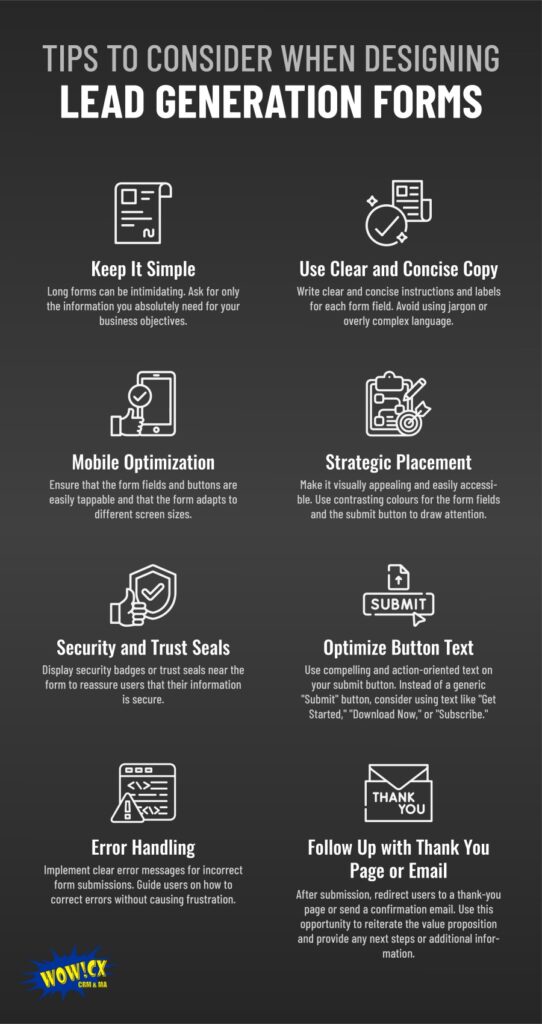Wow!CX CRM provides a powerful solution for startups and small businesses to manage their sales process efficiently. One of the key features of the platform is its form-building capabilities. It helps businesses generate leads, capture important information, and streamline their sales process. Forms in Wow!CX CRM can be leveraged to boost lead generation and drive sales success.
In this blog post, we will unravel the intricacies of lead generation forms, exploring what they are and how they play a pivotal role in driving effective lead generation.
Understanding Lead Generation Forms in Wow!CX CRM
Forms are a type of web-based tool that allows businesses to collect information from their prospects and customers. Lead generation forms serve as digital gateways designed to capture valuable information from potential leads. In Wow!CX CRM, forms can be created and customized to fit the specific needs of a business.
Why are Forms Important for Lead Generation?
Forms play a crucial role in lead generation. They provide businesses with a means to capture and store important information about their prospects and customers. Lead generation forms are instrumental in collecting crucial details like names, email addresses, company information, and more. This information can be used to personalize future outreach efforts, including follow-up emails and calls.
Forms also allow businesses to automate the lead capture process. As a result, they eliminate manual data entry and reduce the chances of human error. This helps businesses streamline their sales process, saving time and increasing efficiency.
The Role of Forms in Effective Lead Generation: Data Acquisition and Integration
Lead generation forms, when integrated seamlessly with CRM systems, play a pivotal role in the acquisition of valuable data.
By strategically designing and implementing such forms, businesses can gather key details that can be used to nurture leads, personalize marketing efforts, and ultimately drive conversions. Here are some ways in which lead generation forms can help capture crucial information:
Crucial Information
Contact Information
Name: Collecting the names of individuals allows for personalized communication.
Email Address: Email is a primary channel for communication and marketing.
Phone Number: Enables businesses to reach out through multiple channels.
Demographic Information
Location: Knowing where leads are located can help tailor marketing strategies based on geographic relevance.
Age: Useful for segmenting and targeting specific age groups with relevant content.
Occupation/Industry: Helps in understanding the professional background of the lead.
Company Details (B2B)
Company Name: Essential for B2B lead generation to target specific businesses.
Company Size: Useful for tailoring services or products to different business scales.
Industry: Enables customization of marketing messages based on industry needs.
Interests and Preferences
Product/Service of Interest: Understanding what specific products or services a lead is interested in allows for targeted follow-ups.
Content Preferences: Knowing whether a lead prefers video content, articles, webinars, etc., helps in delivering content effectively.
Lead Source
How They Found You: Knowing whether leads came from social media, organic search, referrals, etc., helps in optimizing marketing channels.
Challenges and Pain Points
What Challenges They Face: Understanding the pain points of leads helps in tailoring solutions to address their specific needs.
Buying Intent and Budget
Buying Timeline: Knowing when a lead plans to make a purchase decision helps in timing follow-ups appropriately.
Budget: Understanding the budget constraints of a lead helps in offering relevant products or services.
Opt-in Preferences
Subscription Preferences: Allowing leads to specify their communication preferences helps in building trust and maintaining compliance with privacy regulations.
Qualification Criteria
Job Title/Role: Helps in identifying decision-makers within an organization.
Budget Authority: Understanding who holds the budget authority can streamline the sales process.
Feedback and Suggestions
Open-ended Questions: Including a section for comments or suggestions allows leads to provide additional insights that may not be covered in structured form fields.
How to Use Forms in Wow!CX CRM for Effective Lead Generation
Create Custom Forms. Customize your forms to fit the specific needs of your business and capture the information most important to you. You can choose from a variety of form fields, including text boxes, drop-down menus, checkboxes, and more.
Add Forms to Your Website. Embed forms on your website or landing pages to make them easily accessible to visitors. You can also add forms to your email campaigns to capture information from subscribers.
Automate Lead Capture. Use Wow!CX CRM’s automation tools to automatically capture leads from your forms and store them in your CRM. You can also set up automated follow-up emails and calls to engage with leads and move them through your sales pipeline.
Analyze Results. Track the performance of your forms and analyze the data collected to continually improve your lead generation efforts. Wow!CX CRM provides detailed reports on form submissions, conversion rates, and more. You can now make data-driven decisions and refine your strategy.
Conclusion
In conclusion, lead generation forms in CRM are not just digital forms; they are powerful tools that fuel effective lead generation. By capturing crucial information, streamlining processes through automation, designing user-friendly interfaces, leveraging data for personalization, and addressing challenges proactively, businesses can maximize the potential of lead generation forms.
With the ability to customize forms, automate lead capture, and analyze results, businesses can achieve greater sales success and drive growth.


